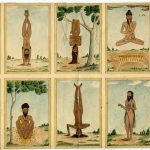PATANJALI’S WISDOM
If you have been doing yoga for a while and never heard of Patanjali, it’s only a matter of time before you cross his path. Patanjali is an Indian sage who extracted the essence of Indian’s spiritual/philosophical traditions and decanted it all in a very condensed form: his 196 ‘Yoga Sutras’. With these concise aphorisms, Patanjali codified India’s sixth philosophical system called Yoga that has been known since then as Patanjala Yoga, Classical Yoga or Ashtanga yoga. That was around 250BCE.
The word ‘sutras’ comes from the word ‘suture’, which conveys the fact that the sentences are short and compact. Every word is deep in meaning and can stand-alone as well as be taken as a whole. Another analogy used to describe the yoga sutras is a pearl necklace, where each pearl (each sutra) stands on it’s own but take their full expression when strung together.
The condensed form of the sutras has another purpose: it can be easily memorised, and memorised they have been and chanted in Indian ashrams up to this day, that’s more then 2000 years.
On a basic level and to put it simply, Patanjali’s sutras give us insights into how the human mind works and how it affects the way we perceive our circumstances and experiences and how we feel about them. The problem he says, is that our perception of the world is limited to our senses. So he suggests that, in order to experience the lightness of being we all seek, the freedom and happiness we want, we need to take some time in our lives to take our attention away from the world we live in and turn it within.
We all know this to a certain extent; that when our lives get too busy, too fast, and too outward reaching it can get overwhelming and challenging to engage peacefully with other people and the world around us. We then tend to crave some quiet time to rebalance ourselves.
On a deeper level, what Patanjali suggests is that by turning our focus from the external world back to ourselves that inner travel itself will slowly draw us toward the light of the soul.
Here something needs to be said about the soul. Yoga is universal and regardless of your religious orientation or whether you are a ‘believer’ or not, a yoga practice will become what it needs to be for you at the time. If we have an affinity for the divine (whatever form or name this takes for us), practising yoga can make us feel more in tune with the sanctity of life. If you don’t relate to such concept, a yoga practice is likely to give you at the very least more strength and stamina to achieve what you want in life and as a result you are likely to slowly develop a sense of gratitude (even awe) toward life.
Coming back to yoga being a path toward the soul, or say, toward oneself Patanjali says that the path of yoga can make us realise that the creative force that keeps the world ticking behind the scene is the same thing that keeps us going. Consciousness is one of the words that are used to express this. It is a difficult concept to grasp but it is expressed beautifully by Yann Martel’s main character in his film ‘Life of Pi: ‘That which sustains the universe beyond thought and language, and that which is at the core of us and struggles for expression, is the same thing.’
Yoga goes a step further, the word Yoga means literally to yoke or unite, and means that we have the potential to actually unite our soul or Individual Consciousness (life force/creative power) with Universal Consciousness (universe’s life force/creative power). This is also called ‘self realisation’ which is what ultimately Yoga is about.
But this is a lofty goal indeed, and first things first: how do we ‘turn our attention within’? Patanjali’s main contribution is the answer to this question. His sutras give us a methodology, a set of practices to experiment with that, and as we do, the awareness of our body, mind and breath slowly sharpens. After a while, the subtler aspect of our being starts to reveal itself.
The Yoga Sutras contain four chapters and the most relevant to a beginner yoga practitioner today is the second chapter called Sadhana pada meaning spiritual path or practice. Central to this chapter is the description of his well known eightfold path, sometimes called ‘8 limbs’ listed below. There is no English word that can translate perfectly the concepts originally written in the Sanskrit language but here is what I gathered from my reading and experience.
1.Yamas – ethical disciplines (relationship with the world)
2.Niyamas – mental disciplines (relationship with oneself)
These first two steps work as a pair. The first one, Yamas is a list of five concepts to be followed if we want to live in harmony with each other. The first yama is ahimsa or non-violence, second, satya, truthfulness, then asteya, non-stealing, bramacharya, control of sensual pleasure and finally aparigraha or non-grasping (a concept quite relevant to redress some of the ills of our troubled times).
As you can see we all practice the yamas already……… to a certain degree. As an exercise, pick one of them and look into it. For example satya (truth). Upon reflection we might find that there are circumstances in which we don’t really tend to tell the truth. And what are the consequences of that? What about our actions being truthful to our words? The more we look into any of the yamas, the more we are likely to find deeper meaning to them. They are multi-faceted and multi-layered. And it is the same for the niyamas.
The list of five niyamas helps us develop a sound relationship with ourselves. First off, saucha, purity or cleanliness (of thought, speech and deed), second, santosha or contentment, third, tapas which means ‘heat’ and is often interpreted as burning desire or asceticism, svadhyaya or self-study as in introspection and studying material related to spirituality. Finally, ishvara pranidhana or surrender to God or surrender to life’s force/creative power).
Patanjali listed the yamas and niyamas knowing that the human condition is such that we tend to have cracks in our behaviour with others and relationship to ourselves.. It can be valuable and interesting to look at, like the great yoga master BKS Iyengar suggests, how we foster (or not) the yamas and niyamas in our yoga practice as well as in our lives. According to Iyengar our yoga practice is a good way to explore our yamas and niyamas. In fact if we practise them in our yoga practice, they slowly start to seep through every aspects of our lives.
3.Asanas – postures
4.Pranayama – breathing techniques
5.Pratyahara – sense withdrawal
Limbs number 3, 4 and 5 form a group of physical disciplines. Asanas meaning yoga postures, which is what is most widely practiced in the world today, pranayama refers to breathing techniques that harness the power of the breath to rejuvenate body systems and pratyahara, which is about techniques to withdraw the senses and turn them within.
6.Dharana – Concentration
7.Dhyana – Meditation
8.Samadhi – State of oneness or Unified Consciousness
The last three limbs are three different gradation of mind stillness. The first is dharana meaning concentrating or focusing the mind on one object, dhyana is a state where the mind sustains concentration within itself over a longer period of time. Samadhi is when duality disappears and the Individual Consciousness merge with the Universal Consciousness. These three last limbs, especially the last, are not to be ‘practiced’ as such, but come as a result of practising the first five limbs.
Each word of each sutra leaves room for interpretation: they need to be ‘decoded’ so to speak and churned over until they make sense to you. When I first started doing yoga more then thirty years ago, Commentaries written on the sutras were few and far between. In the 80’s and 90’s, thanks to the popularity of yoga in the western world, many Commentaries started to emerge and now we can find hundreds of them written by yoga teachers, scholars and philosophers from all sorts of perspectives, some of them more appropriate than others to our contemporary life. Go to bookshops, yoga websites, Google it and explore the sutras for yourself, one spoon full at a time and see how your life is going to change.
Bibliography
BKS Iyengar, Light on the Yoga Sutras, first published by George & Unwin, Great Britain, 1966.
BKS Iyengar, Yaugika Manas, Know and Realise the Yogic Mind. Yog, Mumbai, 2010.
Thank you to the many teachers who have taught and inspired me, especially Rami Sivan, Georg Fueurstein and BKS, Prashant and Geeta Iyengar.





